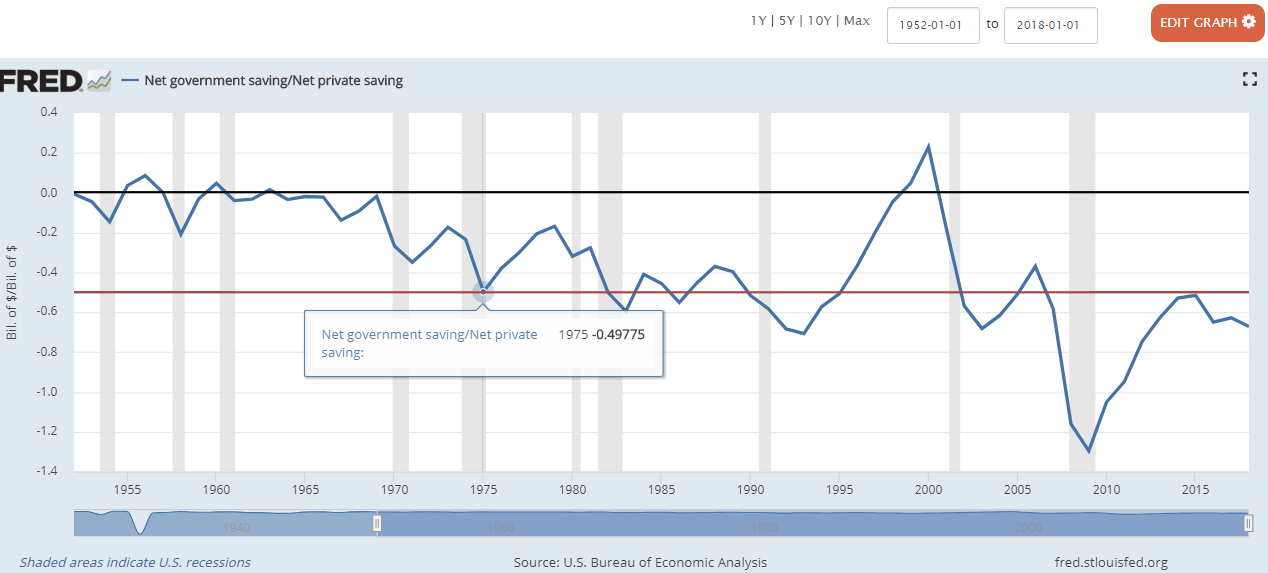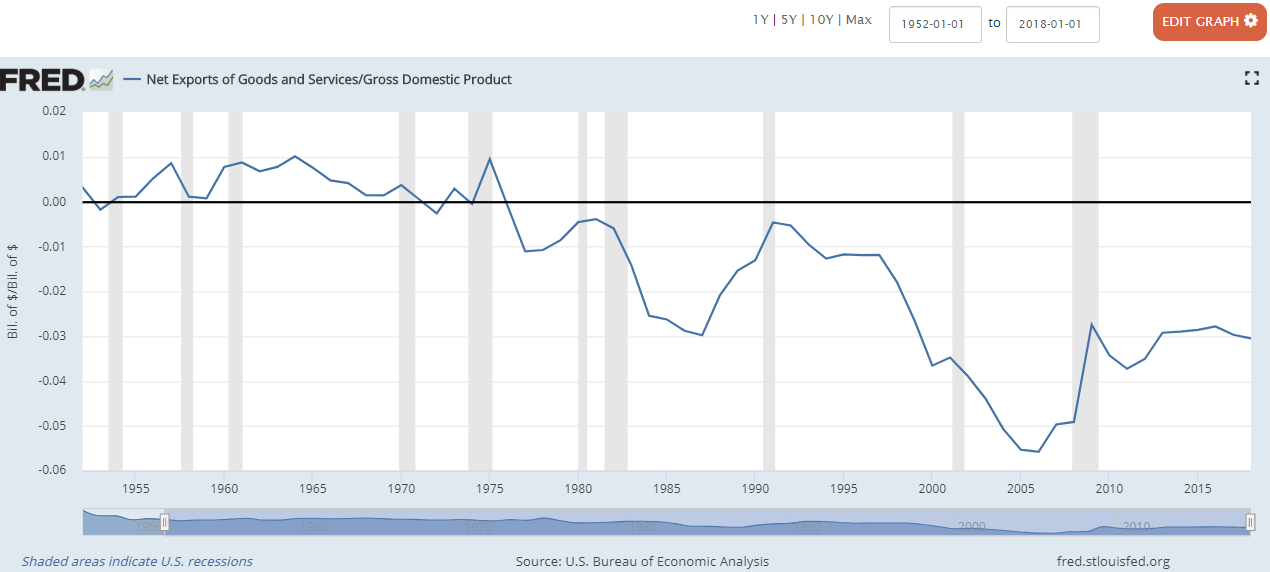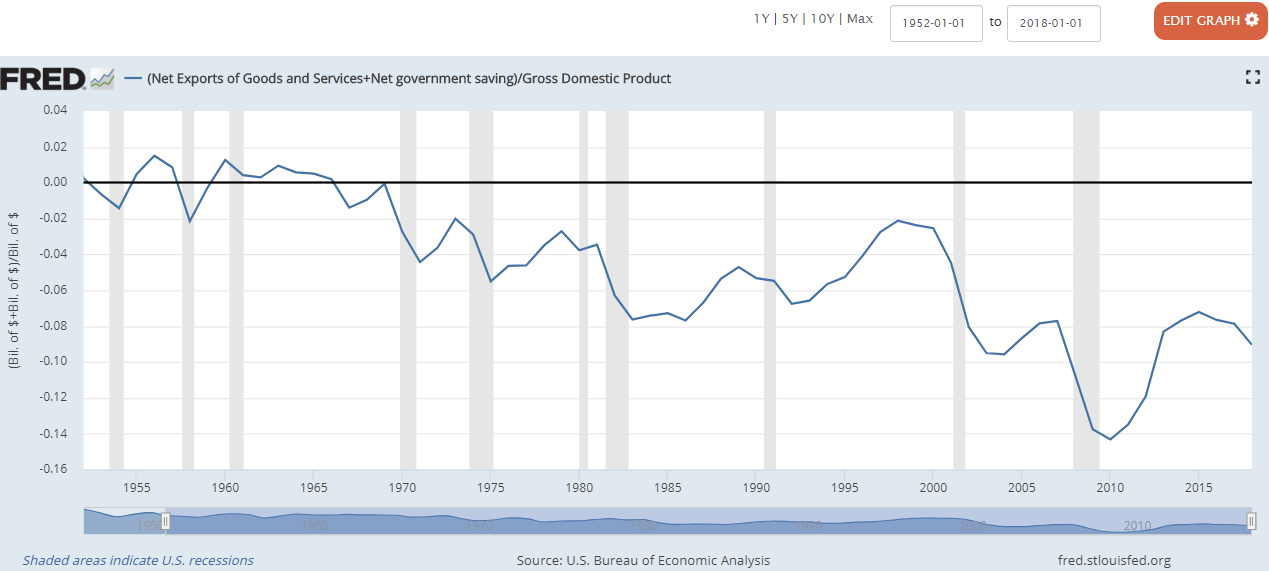The following was written by Minnesota State Content Writer, Edward Thompson. Thompson is a Subject Matter Expert in Economics and Statistics and provides college-level tutoring services.
Federal deficits comprise over 80% of all (federal, state, local) government deficits, and they have far-reaching consequences for both our present competitiveness in the world and for our future as a nation.
When the federal government runs a deficit, it gobbles up some of the supply of savings, crowding out the private investment which would have utilized those savings to grow the economy and keep us competitive as a nation.
Net savings are what you have after replacing worn-out structures and equipment ("worn-out" = depreciation). Net savings represent the money which can actually be put to new uses.
Below is a chart showing the net private savings on top (blue line) and the net government savings (deficits = "negative savings") on the bottom (red line) [1,2]. Note how government deficits are now largely cancelling out (crowding out) private savings.
The shaded area right before 2010 on the chart represents the financial crisis (Great Recession) of 2008, which was "officially" declared to be over by the summer of 2009.
Don't get complacent about that, however, because the deficit spending in 2018 was an even greater share of GDP than it was in 2008 (we're setting ourselves up for another crisis soon).
Here is another chart showing government savings (deficits) as a fraction of private savings--with an added red line representing the point where proportional government deficits (blue line) had gobbled up half of all private savings:
Note how 1975 was the first year that government deficits gobbled up half of all private savings. This makes the U.S. less competitive, so that we can no longer afford to outproduce other nations, resulting in a trade deficit where we import much more than we export (where we buy more from others than they buy from us). Here is a chart for the trade deficit as a fraction of GDP [3,4]:
After 1975 the U.S. became less competitive, and we began running a trade deficit that grew over time (this deficit peaked at almost 6% of GDP and was still just over 3% of GDP in 2018).
The reason this is important is that trade deficits are ultimately financed by selling domestic assets (such as U.S. stocks & bonds) abroad. To continue or increase the trade deficit would mean that foreign investors increase financial interests in the U.S.
A cardinal example of this effect was the sale of American Multi-Cinema (AMC) theaters to a Chinese firm Wanda Group. If trade deficits continue to represent over 3% of our GDP, then there will come a time when most of America would be owned by foreign investors.
It is not good to be so dependent on foreign investors, just to keep our own economy afloat. How did we get here? Let's look at the government deficit as a fraction of GDP.
Again, 1975 was a crucial year. It was the first year that deficit spending by the government represented over 6% of GDP. In 2018, 43 years later, deficit spending still represented about 6% of GDP.
Now, let's look at the combined trade deficit and government deficit to get a sense of how much of our GDP was actually "earned" and how much of it had to be borrowed or "printed" out of thin air (through inflation of the money supply).
Let's single out three years for analysis: 2004, 2010, and 2018. In 2004, 9.6% of GDP was the result of borrowed or printed money. But there is still something missing from this chart: inter-agency loans.
Inter-agency loans are when one government agency borrows from another--such as when money is taken out of the Social Security Trust Fund in order to pay for other things, instead.
The official term is "Intragovernment Holdings" [5]. The amount borrowed in 2004 was $234 billion (about 1.9% of GDP). This means that only 88.5% of GDP was earned in 2004 (11.5% was borrowed or printed).
In 2010 we had just "officially" come out of a recession six months before, but the chart shows that 14.3% of GDP was borrowed or printed.
Adding in the inter-agency loans, we get another 0.9% of GDP--so that only 84.8% of GDP in 2010 was actually earned (15.2% was borrowed or printed). It is important to note that the economy of Greece collapsed when government deficits reached 15% of GDP.
Two things saved the U.S. from the same fate in 2010: some of our borrowing was private borrowing and--with the U.S. dollar being the world's foremost reserve currency--our government can get loans (sell bonds) at the lowest interest rate in the world.
But these two things may not be enough to save us from economic collapse next time. Debt leverage has been increasing in both the private and public sectors now, and along with our upcoming entitlement crisis (both Social Security & Medicare already pay out more than they take in, and it gets worse over time), we are set to be losing our credit rating as a nation in the coming years--which will cause even our interest rates to rise.
At that point, every extra "trillion" in accrued debt gets magnified by any small hike in the interest rate. In our next financial crisis, we will be very close to the position that Greece was in when its economy collapsed.
Let's finish our study with the numbers for 2018.
The chart shows that 9% of GDP had to be borrowed or printed, and adding in the inter-agency loans tacks on another 1% to that. We are still borrowing or printing a full 10% of our annual GDP--over $2 trillion a year!
This cannot continue. Not only is it really bad, but the outlook--including the expected growth in entitlement spending--is even worse.
If you want a bright future for yourself and for your children, then support the Convention of States resolution to use Article V of the U.S. Constitution to enact a convention of states for the limited purpose of proposing specific amendments regarding three vital and necessary topics: restraints on federal spending, restraints on the scope of federal regulations, and term-limits for federal officials.
You future just called, and it said: "Please do this now, before it is too late."
References
[1] U.S. Bureau of Economic Analysis, Net private saving [W202RC1A027NBEA], retrieved from FRED, Federal Reserve Bank of St. Louis; https://fred.stlouisfed.org/series/W202RC1A027NBEA
[Note: business savings + "households & nonprofit institutions" savings = private savings; undistributed corporate profits are 90% of all business savings]
[2] U.S. Bureau of Economic Analysis, Net government saving [A922RC1A027NBEA], retrieved from FRED, Federal Reserve Bank of St. Louis; https://fred.stlouisfed.org/series/A922RC1A027NBEA
[3] U.S. Bureau of Economic Analysis, Net Exports of Goods and Services [NETEXP], retrieved from FRED, Federal Reserve Bank of St. Louis; https://fred.stlouisfed.org/series/NETEXP
[4] U.S. Bureau of Economic Analysis, Gross Domestic Product [GDPA], retrieved from FRED, Federal Reserve Bank of St. Louis; https://fred.stlouisfed.org/series/GDPA
[5] Treasury Direct. The Debt to the Penny and Who Holds It. https://www.treasurydirect.gov/NP/debt/current [set time frame from December 31, 2003 to December 31, 2018 to obtain intragovernmental debt accrued during 2004, 2010, and 2018]


